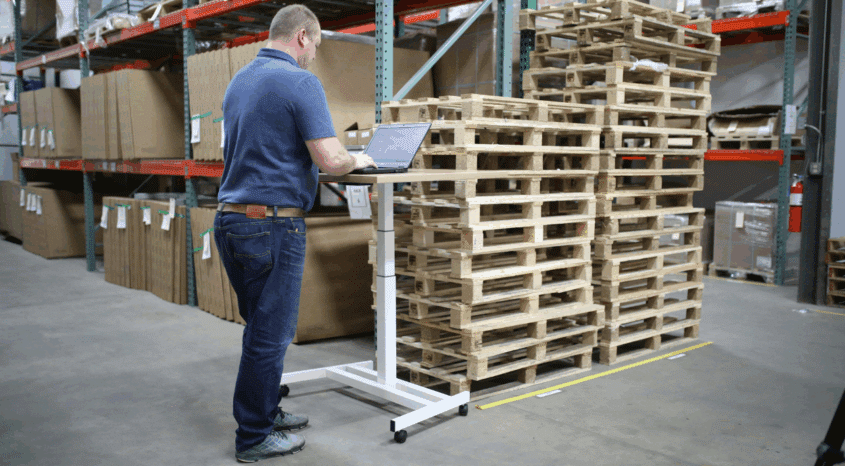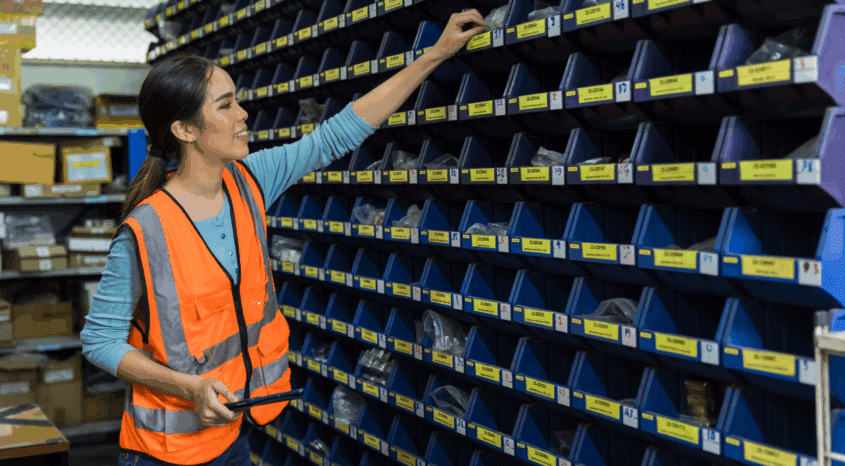Introduction
Outbound logistics has become one of the defining factors in retail and e-commerce success. It covers everything that happens after a product leaves storage, from order processing and packaging to transportation and delivery. Each step in the outbound logistics processes must happen with precision, because customers now expect fast shipping, accurate orders, and hassle-free returns as standard. Businesses that miss the mark risk higher costs, damaged reputations, and lost loyalty.
The pressure to excel in outbound logistics management is only growing as consumer expectations rise and supply chains become more complex. Speed and accuracy are no longer competitive advantages but operational necessities for all outbound logistics processes. Retailers and supply chain leaders who can consistently deliver on both earn customer trust, protect margins, and create a foundation for sustainable growth.
What is Outbound Logistics?
Outbound logistics refers to the processes involved in moving the finished product from a company’s warehouse or distribution center to the final destination, which is typically the end user. Outbound logistics processes include order processing, inventory handling, packing, shipping, and delivery, as well as the systems that manage returns. The goal is simple: get the right product to the right customer at the right time, in the right condition, and at the right cost.
Outbound logistics processes as a whole are sometimes referred to as distribution or fulfillment, terms often used interchangeably across industries. In retail, it includes activities such as picking and packing online orders, shipping products to stores, and managing customer returns.
One outbound logistics example would be a fashion retailer receiving an online order: the order is processed, the finished product is picked from inventory, packed securely, staged for loading, shipped out, and delivered to the final destination. Similarly, a grocer coordinating a delivery to a household, or an electronics company delivering a bulk order to a retail chain, all illustrate how outbound logistics processes ensure products reach the end user efficiently.
The Difference Between Inbound and Outbound Logistics
Inbound and outbound logistics are both essential components of supply chain management, each playing an essential role in efficient operations and customer satisfaction. Inbound logistics concentrate on sourcing and transporting raw materials or products from suppliers into storage or production facilities. This inbound logistics process involves activities such as receiving, inspecting, and storing raw materials, and is essential for reducing costs and maintaining product quality.
Outbound logistics focuses on delivering finished products to customers after production is complete. While inbound logistics affects how well a business can prepare to sell, outbound logistics directly shapes the customer experience.
Challenges in Outbound Logistics Processes
Even the most efficient retail and e-commerce operations face hurdles in managing outbound logistics. The challenges of outbound logistics create bottlenecks in supply chain management that reduce speed, add costs, and increase the risk of errors. Understanding them is the first step toward building a strategy that delivers both accuracy and efficiency.
Inventory Mismanagement
Poor visibility into stock levels and ineffective inventory management can cause a range of problems, including both stockouts and overstocking. Stockouts leave customers disappointed, while overstocking ties up working capital and increases storage costs. Monitoring inventory turnover is crucial for measuring how efficiently inventory is utilized and for identifying slow-moving stock. It is also important to track inventory planning metrics such as sell-through rate and days on hand to ensure inventory levels align with customer demand and to manage inventory costs effectively. Failing to address excess inventory can lead to higher inventory costs and operational inefficiencies. Inaccurate records can also lead to mispicks, where the wrong items are shipped, driving up returns and eroding customer satisfaction and trust.
Rising Shipping Costs and Delays
Transportation remains one of the most expensive components of outbound logistics. Fuel costs are a significant component of overall shipping expenses, as fluctuations in fuel prices directly impact the bottom line. Transportation costs, including carrier rates, fuel surcharges, and regional fees, are also important factors in outbound logistics and represent a major cost driver for companies. Optimizing outbound transportation through route planning, carrier negotiation, and technology can help control costs and improve delivery speed. Building strong relationships with freight providers is also crucial, as collaborating with freight providers can help negotiate better rates, optimize shipping agreements, and improve overall logistics efficiency. On top of costs, delivery delays caused by congestion or broader supply chain management disruptions can damage reliability and customer confidence.
Multi-Channel Complexity
Selling across multiple platforms creates significant operational challenges. Managing multiple distribution channels, such as direct and indirect routes, increases logistics complexity and requires careful coordination. Orders must be synchronized across marketplaces, direct-to-consumer sites, and physical stores. To ensure efficient fulfillment, businesses need to coordinate different methods across distribution channels, such as drop shipping and omnichannel strategies. Without unified systems, logistics operations can become highly complex, leading to data silos, inconsistencies in stock levels, and difficulties managing fulfillment across multiple warehouses or distribution centers.
Returns and Reverse Logistics
High volumes of returns have become the norm in many retail sectors, particularly apparel and electronics. Processing delays frustrate customers, while the expenses tied to restocking, refurbishing, or discarding returned items quickly add up. Poorly managed returns also undermine customer loyalty.
Labor Shortages and Seasonal Spikes
Finding and retaining skilled workers is a constant challenge. Seasonal demand surges only intensify the pressure, forcing businesses to rely on temporary staff. Without sufficient training, performance varies, and errors in picking, packing, or shipping become more frequent during the times when accuracy matters most.
Manual Processes and Legacy Systems
Many businesses still rely on outdated methods that cannot keep up with modern retail. Paper-based systems and spreadsheets slow down order processing, while disconnected tools make it difficult to track shipments in real time. Manual data entry introduces errors that cascade through the supply chain, creating costly inefficiencies. To address these challenges, companies need to streamline operations by adopting modern technology and integrated systems that leverage high-quality data for greater efficiency.
Why Speed and Accuracy Are Critical in Outbound Logistics
Outbound logistics is more than a back-end operation. It is one of the most visible parts of the customer experience. When shipments arrive quickly and correctly, it builds trust and encourages repeat purchases. When they do not, the damage to customer loyalty can be immediate. Efficient outbound logistics not only streamlines operations but also improves customer satisfaction and overall business performance.
Poor outbound logistics can impact:
- Customer loyalty: Timely delivery encourages repeat business, while late or inaccurate orders often lead to negative reviews and lost sales.
- Cost control: Accuracy reduces mispicks, reshipping, and returns, while precise inventory tracking prevents overselling and costly backorders.
- Competitive edge: Fast fulfillment is now an expectation, with same-day and next-day shipping becoming standard benchmarks. Businesses that cannot keep pace risk losing customers or failing to meet customer demand.
- Buying behavior: Delivery speed and reliability influence decisions at checkout. Long shipping times drive cart abandonment, while dependable commitments increase completed purchases and repeat orders.
Improving outbound logistics can improve customer satisfaction and lead to fewer order cancellations, strengthening overall business performance.
How to Improve Outbound Logistics For Speed and Accuracy
Improving outbound logistics requires a balance of process refinement, technology adoption, and operational discipline. By focusing on the right areas, businesses can deliver faster, reduce errors, and keep costs under control.
When deciding where to focus improvement efforts, it helps to keep two guiding frameworks in mind:
The 7 C’s of Supply Chain Management
- Connect: Build strong links with suppliers, partners, and customers to reduce disruptions.
- Create: Use innovation and technology to streamline logistics and cut costs.
- Customize: Adapt services and delivery options to meet customer needs.
- Coordinate: Align carriers, warehouses, and suppliers to keep goods moving.
- Consolidate: Combine shipments and resources to improve efficiency.
- Collaborate: Work with partners to share strengths and enhance performance.
- Contribute: Add value by staying compliant, sustainable, and aligned with goals.
The 4 P’s of Logistics
- Product: Deliver the right items in the right condition.
- Price: Control logistics costs without reducing service quality.
- Place: Ensure goods consistently arrive at the correct destination.
- Promotion: Support brand promises through reliable delivery performance.
These principles serve as a foundation for any logistics strategy. With them in mind, businesses can take targeted steps to strengthen outbound operations and deliver measurable improvements.
1. Automate Order Processing
Manual order entry is one of the most common causes of slow fulfillment and mistakes. Automation speeds things up by pulling orders directly from every sales channel into a central system. This eliminates duplicate entries, reduces human error, and ensures each order is ready for fulfillment immediately after purchase. Faster processing not only improves efficiency but also helps businesses meet customer expectations for rapid shipping.
2. Optimize Warehouse Operations
The warehouse is the center of outbound logistics, and even small inventory management improvements here can have a big impact. Barcode scanning reduces picking mistakes, while digital pick lists guide staff through the most efficient routes. Techniques such as batch or wave picking increase speed in high-volume environments. Standardizing packing procedures also helps protect products in transit and ensures customers receive orders in the right condition.
3. Enhance Inventory Visibility
Accurate inventory data is essential for speed and reliability. Real-time visibility ensures stock levels are updated instantly across all sales channels, preventing overselling or stockouts. Forecasting tools can anticipate spikes in demand and help businesses adjust purchasing accordingly. Automating reorder points further reduces the risk of running out of best-selling items, keeping fulfillment smooth even during busy periods.
4. Improve Shipping and Delivery
Shipping is the final stage of outbound logistics management and the most visible to customers. Carrier integrations allow businesses to access competitive rates and select the best delivery method for each order. Automated label creation and documentation reduce delays at dispatch. Shipping rules, such as routing by weight or location, streamline the process even further and keep costs predictable.
5. Manage Returns Efficiently
Returns are a reality in retail, but they do not have to be a burden. Efficient processes can turn returns into opportunities to recover value. Pre-approved labels and automated return confirmations make the process easier for customers. Once items are received, quick inspection and restocking minimize losses and keep inventory accurate. Using rapid replenishment methods further optimizes inventory management and ensures the timely availability of products. Analyzing return trends also helps businesses identify recurring issues, such as product defects or sizing inconsistencies.
Using Automation to Improve Outbound Logistics
Automation is one of the most effective ways to improve both speed and accuracy of the entire outbound logistics process. By reducing manual processes, businesses can fulfill more orders, cut down on errors, and keep costs under control.
Order processing is often the first area to benefit. Instead of retyping data, orders flow directly from sales channels into a central system, making them ready for picking and packing almost instantly. In the warehouse, barcode scanning and guided pick lists help staff work quickly while reducing mispicks, and automated packing steps ensure items leave in the right condition. Shipping integrations then complete the process by generating labels and selecting the best carrier without delay.
The advantages of automation extend across the entire outbound journey:
- Faster processing ensures orders move from confirmation to dispatch more quickly.
- Fewer errors reduce costly returns and reshipping.
- Consistent processes make it easier to handle spikes in demand.
- Scalability allows operations to grow without proportional increases in labor.
With automation in place, outbound logistics becomes a predictable, efficient system that strengthens customer satisfaction and supports long-term business growth. Implementing an outbound logistics system can further enhance automation and efficiency by streamlining operations, improving data sharing, and ensuring timely delivery.
How Brightpearl Helps Improve Outbound Logistics
Brightpearl takes the complexity out of outbound logistics. Its automation engine, centralized data, and flexible fulfillment options help retailers and e-commerce businesses pick, pack, and ship more orders in less time with fewer mistakes.
Key features that improve outbound logistics include:
- Automation of fulfillment tasks: Automates order splitting, backorders, dropshipping, and invoicing to save time and cut errors.
- Multi-warehouse fulfillment: Routes orders to the best location automatically, reducing delays and transfers.
- Flexible shipping options: Connects with Amazon FBA, 3PLs, and carriers like Shipstation and Shiptheory in one place.
- Smart shipping rules: Chooses the most cost-effective or fastest carrier based on price, weight, or order type.
- FIFO order routing: Uses older inventory first to keep stock fresh and reduce waste.
- Dropshipping management: Creates rules by product, channel, or customer to simplify dropshipping.
- Centralized visibility: Syncs sales, warehouses, and carriers in real time, keeping teams and customers updated.
These tools transform outbound logistics into a streamlined, automated process that saves time, lowers costs, and delivers a better customer experience.
Turning Outbound Logistics into a Competitive Advantage
Speed and accuracy in outbound logistics services are no longer optional. They shape how customers perceive a brand, influence repeat purchases, and directly impact profitability. Businesses that continue relying on manual processes or disconnected systems risk falling behind, while those that embrace automation and integration can turn logistics into a true differentiator.
Brightpearl equips retailers and e-commerce businesses with the tools to streamline fulfillment, optimize shipping, and maintain real-time visibility across every channel. The result is an outbound logistics operation that is faster, more reliable, and easier to scale.
To see how Brightpearl can help your business strengthen its logistics and deliver a better customer experience, book a demo today and discover how speed and accuracy can become your competitive edge.



